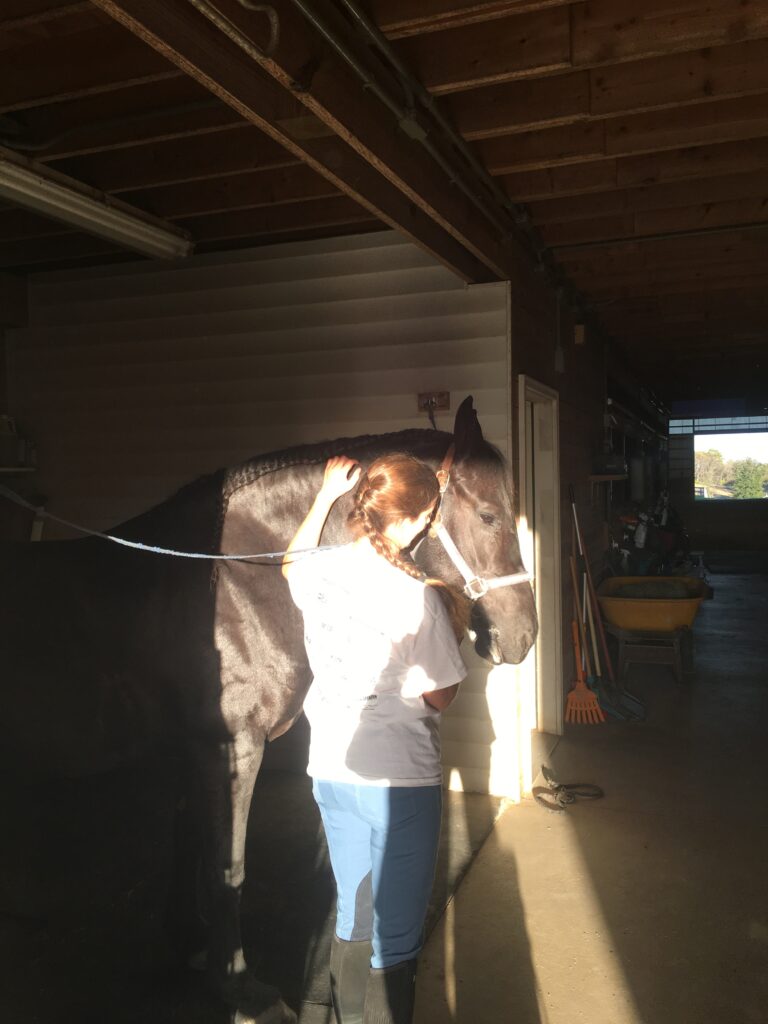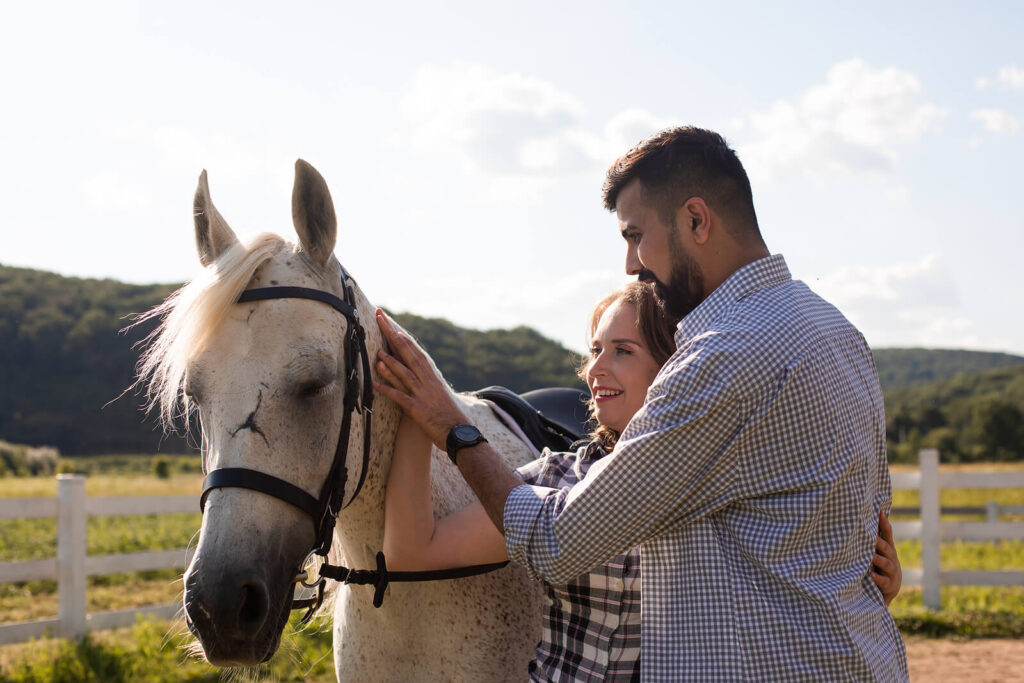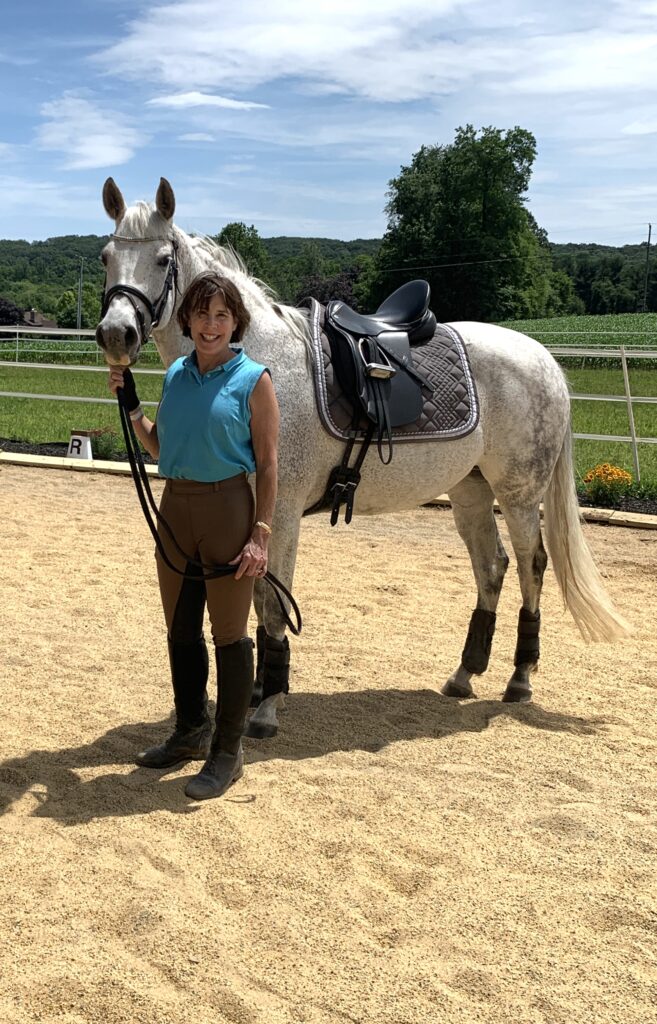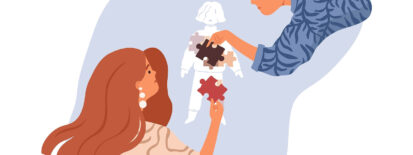A Guest Blog Post By Mary Sue McCarthy, LCPC, NCC, EMDR-Certified for Trauma Therapist Network
How Can Equine Therapy Heal Attachment Wounds & Trauma?

I have personally experienced the magic of the connection that comes with being in partnership with a horse, having been around horses almost my whole life. I’ve seen horses forced into relationship, kept in toxic relationships, and abused in relationships. Seeing such things hurt my heart, and I know instinctively that it hurts the horse’s heart, too! I imagined there must be a better way to create a partnership with a kind and loving animal that allows humans to ride on its back and place cold, hard metal bars in its mouth (the bit), to assist riders with steering.
As a trauma therapist with a background in addictions work, I am a resource for clients who need help understanding and resolving trauma symptoms. I almost always notice that my clients bring anxiety, concern, and confusion around how to develop relationships that feel balanced, mutually comfortable, and supportive.
Most of my clients hold memories of very chaotic childhoods, and often of being forced at early ages to become the family “fixer,” the person who feels responsible for other people’s emotions. It’s incredibly stressful for children to exist in a space of hyperarousal, watching and waiting for the next unpredictable violence, whether physical, verbal, or emotional. Of course, it is impossible for a child to prevent or manage an adult’s behavior, and no child is responsible for carrying the burden of their caregivers’ emotions.
Readers of this article may be familiar with trauma responses such as:
- Dissociation
- Hiding
- Separation of mind from body
- Extreme anger
- Fits of explosive rage
All of these trauma reactions can arise when a child lacks the basic safety we all need from our caregivers during childhood. These are normal responses to trauma, but these reactions can make it difficult for a child to develop safe connections and attachments.
Thus, the child growing up in a chaotic, unpredictable home develops the belief that people are dangerous or unsafe and that connection to another will do nothing more than hurt and disappoint. They may also feel responsible for keeping their family members safe, and may be overwhelmed with their own unexpressed pain.
Attachment Is A Survival Need for Humans
It is innate in humans to seek attachment, comfort, and safety from their primary caregivers. When these attachment needs are not met consistently enough, the child (and later adult) will likely struggle in relationships with peers, romantic partners, parents, teachers, and other authority figures, reinforcing the child’s suspicion that other people are unsafe and that they themselves are unlovable. This is what trauma therapists often refer to as “attachment rupture,” and can lead to a diagnosis of Attachment Disorder.
Fortunately, our brains have neuroplasticity, meaning their development continues over the lifespan and they can heal from the injuries of poor-quality attachment relationships in our earliest years. And it is here that the magic of equine psychotherapy comes in.
According to Louis Cozolino, author of The Neuroscience of Human Relationships,
Relationships are our natural habitats.
Louis Cozolino, Author of The Neuroscience of Human Relationships
Here’s Where the Magic of Equine Therapy Comes In
Most of the following information is adapted from my training with the Natural Lifemanship Institute, which I consider to be the premier trainer in Equine Therapy.
As prey animals, horses are most often prepared to fight or flee when they perceive danger. Their brain development is organized as might be that of a young human child who is living in a chaotic environment. Trauma-impacted human and equine brains organize around the need for constant vigilance and preparation to avoid threat – their nervous systems are in a state of hyperarousal.
Like Humans, Horses Seek Connection For Survival
Both horses and humans also seek connection for survival. Most of us know that horses live in herds, and one of the most destructive things we humans can do to a horse is to separate it from its herd, which is its central place of safety.
The goal of working with horses, according to the Natural Lifemanship Institute, is “to help our clients develop relationships in which they learn to ask for what they need from others in ways that respect others’ freedoms, and to respond rather than react. We teach our clients to build a connected relationship by asking for attachment from a horse as well as detachment, or distance, with connection.”
Boundaries With Consent
In TF-EAP (Trauma-Focused Equine Assisted Psychotherapy), counselors structure activities in the arena to help a client ask for attachment from their horse in a way that respects the horse’s ability to make any of three choices:
- To ignore
- To resist, or
- To cooperate.
Note: Just as any good therapist might do in traditional talk therapy, we do NOT decide in advance of our session what we think the client needs for that day’s session.
Rather, we follow our client’s lead in the arena, to help them be curious, notice, and seek clarity around their internal and external reactions to others – in this case, the horse! The client has the opportunity to experience in real-time the internal and external reactions that come up within their relationships as they practice with the horse.
What Happens During A TF-EAP (Equine Therapy) Session?

Let’s use the example I mentioned at the beginning of this article. A child who is raised in a chaotic environment with inconsistent nurturing becomes an adult who understandably struggles to attune with others who are seeking attachment with her.
As a therapist practicing TF-EAP I have a human partner in the session, the Equine Professional (EP), who handles the horse while we work with the client to build relationship with the horse partner. Together with the EP, I would invite the client to practice seeking a connected, consenting attachment with her horse partner.
This might look like:
- The client sits across from the horse sharing the same space; or
- The client makes a request for physical connection with the horse.
We Have To Take A Risk in Equine Therapy To Allow Connection
As you can imagine, it can be incredibly scary to request a connection in an attuned way when one hasn’t had the experience of a safe, secure attachment. There is a saying in the trauma field that what has been broken in a relationship (i.e. trust) must be healed in a relationship. This is why the experiential work of Equine Therapy is so powerful!
It is incredibly brave of someone who has been wounded in their most vulnerable moments by a betrayal of trust, rejection, abuse, and/or trauma to take a chance on making a connection with a horse. There is such a huge risk of showing vulnerability and being hurt again; and there is an understandable fear of rejection, by being ignored or not seen when attempting to connect with the horse.
Goals of TF-EAP Sessions: Attachment & Detachment With Connection
When working toward attachment, counselor and client are seeking a means of establishing healthy connection with others. Together with the client, we might co-create goals to: work through internalized fears of rejection and understand how those fears show up in the body; build confidence and belief that it is possible to create connection with another being; and develop the capacity to tolerate the horse making its own choice whether or not to connect.
The trauma therapist is aware that asking for a healthy connection with others, including horses, does not always result in the outcome we seek. Although we may want to attach, internal states may create energy that is sensed by the horse and causes it to be uncomfortable connecting with us.
There are times in the arena when our equine partners will not connect and are distracted, frightened, or concerned by their sense of what is radiating from our bodies, even if we don’t feel it. These moments present opportunities for mindful observation of our relational patterns as well as the horse’s relational patterns.
Here is What You Can Expect in Equine Therapy
In a TF-EAP session, the psychotherapist may simply invite a client to begin a relationship with a horse in any way that feels appropriate. The therapist and EP are a team providing a safe space in the arena or out in the field for the client to begin connecting with the horse in the way that feels most comfortable for them. If the client is unable to create a relationship with the horse, valuable information has been gained that can help the client and therapist understand where the healing needs to happen. Such inability to connect may mirror the client’s experiences in trying to connect with humans. The client may decide they would like to process emotions about this, reflect on the barriers to connection, and set goals from there.
Understanding Detachment With Connection in Equine Therapy
Part of attaching in a healthy way is being able to detach while remaining connected. For those of us whose relational styles require continuous reassurance and demands for proof of connection, including unrealistic expectations of physical proximity, it can be helpful to work on detachment with connection in TF-EAP sessions.
These sessions are slightly different. Detachment with connection involves an approach with a horse asking for physical distance while still in connection. If we have experienced emotional or physical abandonment in childhood, detachment can be a serious challenge for clients, due to internally surfacing memories and symptoms (like somatic expressions) which interfere.
What Do Trauma Therapists Need To Know About Equine Assisted Psychotherapy?
The sessions my EP partner and I offer are about 60 minutes long. Most equine work is private pay, but therapists can explore billing the session as “off-premise therapy.” To do this work you need certain key elements:
- Proper training and comfort around horses;
- A license to practice therapy;
- A trained equine professional who can hold a safe space for the work for both the horse and the client;
- Horses who are comfortable around people and receptive to connection.
- A farm or barn owner who is willing to offer their facility and horses, and who is comfortable with the liability involved in therapy work with horses.
- Obviously, several important liability releases are necessary with each property owner. I have my own release of liability as does the farm where I do this work.
Do Therapists Need to Have A Background in Horses?
Trauma therapists have asked me if they need to have a background in horses. Such a background makes the process much easier to learn, but it is not necessary as long as the therapist is working with a skilled equine professional. The therapist and EP work together seamlessly to provide a safe learning space.
Ideally, the therapist and the EP partner support each other. They discuss differences of approach or opinion out of the view of the client, with each being flexible and willing to listen to the other. That said, if the EP deems the environment unsafe, the session should be stopped.
Interestingly, a situation like this offers an excellent opportunity for processing how the client might react to feeling unsafe or the closing down or loss of her reach for connection.
What is Important for Trauma Therapists to Know About TF-EAP?
I would say that important capacities for both the therapist and EP are patience, trust, and confidence in the process, the ability to contain countertransference and to observe. It is critical that the therapist allow and hold space for the client’s patterns to unfold organically in a nuanced way. This requires astute observation, without judgment.
Trauma Focused Equine Assisted Psychotherapy is not talk therapy. The client is encouraged to move and experience the process somatically, using the space with the horse in a way feels authentic. It is in the processing, most likely at the end of the session or beginning of the following session, that observations are shared and meaning-making explored.
The Magic of TF-EAP is Rooted in Neuroscience
Equine therapy is a refreshing and creative alternative or supplement to in-office sessions. Just being outdoors with the space for somatic expression evokes a client’s five-sense capacity. As we have learned through the lens of Somatic Experiencing and Sensorimotor Psychotherapy, the human-equine relationship promotes body/mind integration, neuroplasticity, and cross-brain activity, embedding new cognitive and behavioral patterns.
Horses give us the chance to feel into, rather than just think into, the changes we have been striving to make. According to trauma researcher Bessel van de Kolk, author of The Body Keeps The Score: Brain, Mind, and Body in the Healing of Trauma, “trauma memory is stored in our bodies and healing occurs when we befriend what is going on in our bodies”. Horses, hard-wired just as we are for survival through connection, are exemplary partners as we walk the way of emotional regulation, wise choices, and a confirmed sense of self and other.
For more information on Trauma-Focused Equine Assisted Therapy ( TF-EAP) visit: www.naturallifemanship.com

Mary Sue McCarthy, LCPC, NCC, is a second level Natural Lifemanship practitioner working toward her final certification. In private practice in Hunt Valley, Maryland, Mary Sue welcomes clients 25 years and older for support with recovery from trauma and related symptoms including addictions, depression, social isolation and “feeling stuck.” She is a Maryland Registered and Board Approved Clinical Supervisor and is available for consultation with therapists seeking to start their own TF-EAP practices. She can be reached at [email protected] or 410-979-7744. Her website is: www.marysuemccarthy.com.




